
1537 Bay Dr
Yuba City CA 95993-8297
Inspector: Joshua McGrath
Certified Home Inspector


Sample Report
| Client(s): | John Smith |
| Property address: | 1234 Main Street |
| Inspection date: | Tuesday, April 15, 2014 |
This report published on Saturday, April 26, 2014 1:08:13 AM PDT
Thank you for choosing Twinspections to perform your home inspection. The goal of
this inspection and report is to put you in a better position to make an informed real estate decision. This
report is a general guide and provides you with some objective information to help you make your own
evaluation of the overall condition of the home and is not intended to reflect the value of the property, or to
make any representation as to the advisability of purchase. Not all improvements will be identified during this
inspection, as some areas of the home are not visible or beyond the scope of the inspection. Unexpected repairs should still be anticipated. This inspection is not a guarantee or warranty of
any kind.
The report is effectively a snapshot of the house, recording the conditions on a given date and time. Home
inspectors cannot predict future behavior, and as such, we cannot be responsible for things that occur after
the inspection. If conditions change, we are available to revisit the property and update our report.
The report has been prepared for your exclusive use, as our client. No use by third parties is intended, unless approved by the client (i.e. real estate agent, mortgage lenders, ect.) We will
not be responsible to any parties for the contents of the report, other than the party named in this document.
Twinspections would like to thank you for your business and to remind you that we are available throughout your home buying/selling process, please call or email if you have any questions.
How to Read this Report
This report is organized by the property's functional areas. Within each functional area, descriptive information is listed first and is shown in bold type. Items of concern follow descriptive information.
Concerns are shown and sorted according to these types:| Safety | Poses a safety hazard | |
| Repair/Replace | Recommend repairing or replacing | |
| Repair/Maintain | Recommend repair and/or maintenance | |
| Minor Defect | Correction likely involves only a minor expense | |
| Maintain | Recommend ongoing maintenance | |
| Evaluate | Recommend evaluation by a specialist | |
| Monitor | Recommend monitoring in the future | |
| Serviceable | Item or component is in servicable condition | |
| Comment | For your information |
Click here for a glossary of building construction terms.Contact your inspector If there are terms that you do not understand, or visit the glossary of construction terms at http://www.reporthost.com/glossary.asp
Table of Contents
General InformationGrounds
Exterior and Foundation
Water Heater
Roof
Attic and Roof Structure
Heating, Ventilation and Air Condition (HVAC)
Electric
Plumbing / Fuel Systems
Kitchen
Bathrooms, Laundry and Sinks
Interior, Doors and Windows
Garage or Carport
General Information
Report number: 040114-01
Time started: 8:00 a.m. PST
Time finished: 10:30 a.m. PST
Present during inspection: Client, Realtor
Client present for discussion at end of inspection: Yes
Weather conditions during inspection: Dry (no rain)
Temperature during inspection: Cool
Inspection fee: 300.00 USD (350.00 minus 50.00 coupon)
Payment method: Cash
Type of building: Single family
Buildings inspected: One home w/attached garage
Number of residential units inspected: 1
Age of main building: 7 Years
Source for main building age: Owner
Front of building faces: East
Main entrance faces: East
Occupied: No
1)
2)
3)
4)
Also, it is beyond the scope of this inspection to determine if all permits have been approved or signed off. Consult with the builder and/or municipality to determine if all necessary permits have been approved.
Grounds
Limitations: Unless specifically included in the inspection, the following items and any related equipment, controls, electric systems and/or plumbing systems are excluded from this inspection: detached buildings or structures; fences and gates; retaining walls; underground drainage systems, catch basins or concealed sump pumps; swimming pools and related safety equipment, spas, hot tubs or saunas; whether deck, balcony and/or stair membranes are watertight; trees, landscaping, properties of soil, soil stability, erosion and erosion control; ponds, water features, irrigation or yard sprinkler systems; sport courts, playground, recreation or leisure equipment; areas below the exterior structures with less than 3 feet of vertical clearance; invisible fencing; sea walls, docks and boathouses; retractable awnings. Any comments made regarding these items are as a courtesy only.
Site profile: Backyard is level, front has adequate slope.
Condition of driveway: Appeared serviceable, minor cracks are normal. No tripping hazards present
Driveway material: Poured in place concrete
Condition of sidewalks and/or patios: Appeared serviceable
Sidewalk material: Poured in place concrete
5)
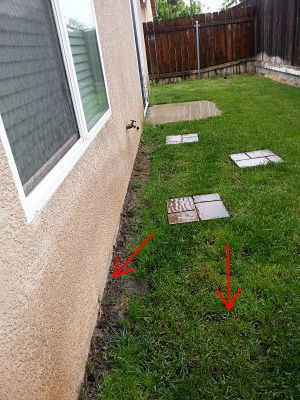 Photo 5-1 Soil does not slope away from structure and has no existing drainage system. Also, soil is within 6 inches of contact with stucco siding. This can cause damage from insects and water penetration.
|
6)
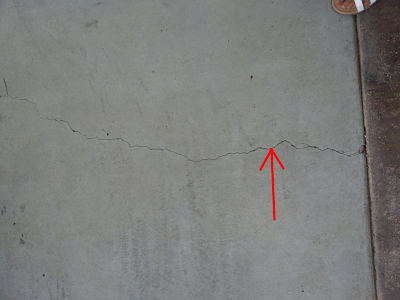 Photo 6-1 |
7)
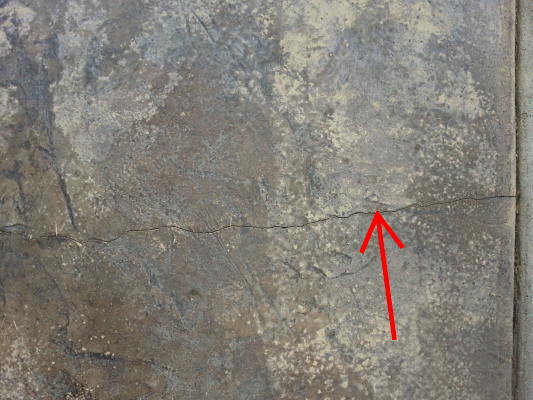 Photo 7-1 |
Exterior and Foundation
Limitations: The inspector performs a visual inspection of accessible components or systems at the exterior. Items excluded from this inspection include below-grade foundation walls and footings; foundations, exterior surfaces or components obscured by vegetation, stored items or debris; wall structures obscured by coverings such as siding or trim. Some items such as siding, trim, soffits, vents and windows are often high off the ground, and may be viewed using binoculars from the ground or from a ladder. This may limit a full evaluation. Regarding foundations, some amount of cracking is normal in concrete slabs and foundation walls due to shrinkage and drying. Note that the inspector does not determine the adequacy of seismic reinforcement.
Wall inspection method: Viewed from ground
Condition of wall exterior covering: Repairs recommended, see below
Apparent wall structure: Wood frame
Wall covering: Stucco
Condition of foundation and footings: Appeared serviceable
Apparent foundation type: Concrete slab on grade
Foundation/stem wall material: Concrete slab on grade
Footing material (under foundation stem wall): Not determined (inaccessible or obscured)
8)
9)
 Photo 9-1 Soil does not slope away from structure and has no existing drainage system. Also, soil is within 6 inches of contact with stucco siding. This can cause damage from insects and water penetration.
|
10)
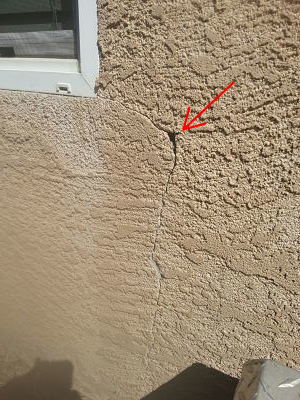 Photo 10-1 Large crack, south-facing wall in backyard. This crack is over 1/8 inch and requires repair.
|
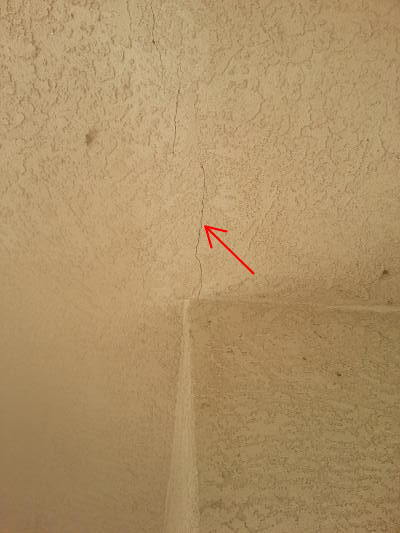 Photo 10-2 Small settling crack above front entryway porch. This crack is only a cosmetic issue at the moment.
|
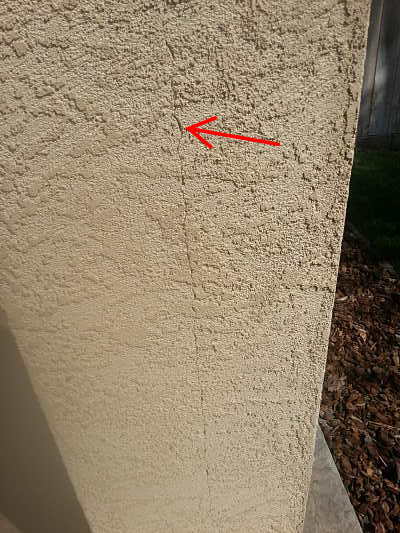 Photo 10-3 There is a similar structural settling crack in the center of each pillar out front. These are common in stucco and cosmetic at this time.
|
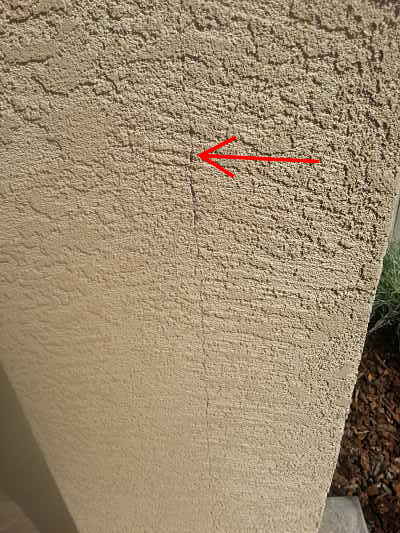 Photo 10-4 |
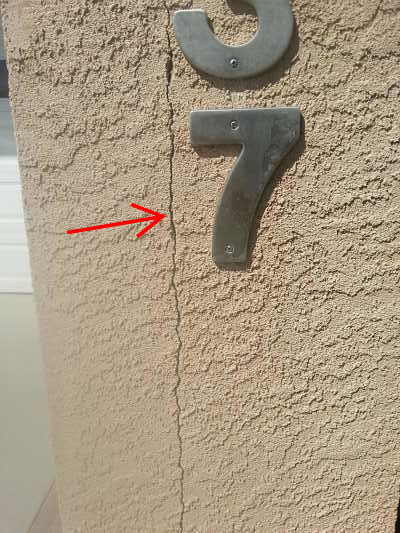 Photo 10-5 The larger crack of the three pillars out front. At this point it is still cosmetic.
|
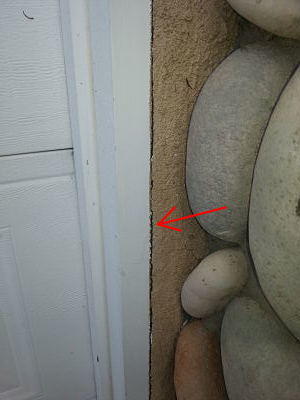 Photo 10-6 Separation between garage door frame and stucco should be inspected and repaired by a qualified contractor.
|
11) service vent outside has inappropriate install. This install leaves vent open to insect incursion. Recommend proper install.
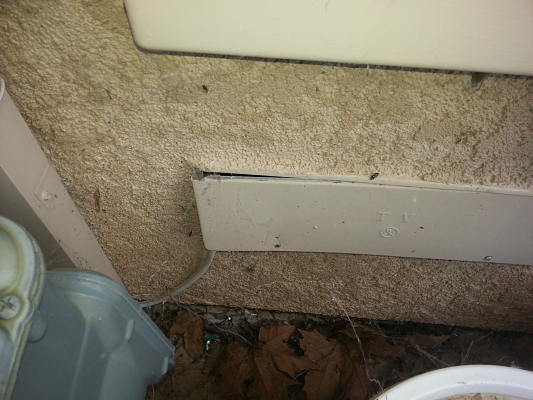 Photo 11-1 |
Water Heater
Limitations: Evaluation of and determining the adequacy or completeness of the following items are not included in this inspection: water recirculation pumps; solar water heating systems; Energy Smart or energy saver controls; catch pan drains. Any comments made regarding these items are as a courtesy only. Note that the inspector does not provide an estimate of remaining life on water heaters, does not determine if water heaters are appropriately sized, or perform any evaluations that require a pilot light to be lit or a shut-off valve to be operated.
Condition of water heater: Appeared serviceable
Type: Tankless
Energy source: Natural gas
Estimated age: 6 Years
Capacity (in gallons): 177 gallons/hour. Tankless water heaters are supply on demand and energy efficient.
Temperature-pressure relief valve installed: Yes
Location of water heater: Backyard Exterior, South-Facing
Hot water temperature tested: Yes
Water temperature (degrees Fahrenheit): 116 degrees. This is within the average temperature of 110-120 degrees fahrenheit. Be advised water temperature above 120 degrees fahrenheit can cause scalding.
Condition of burners: Appeared serviceable
Condition of venting system: Appeared serviceable
12)
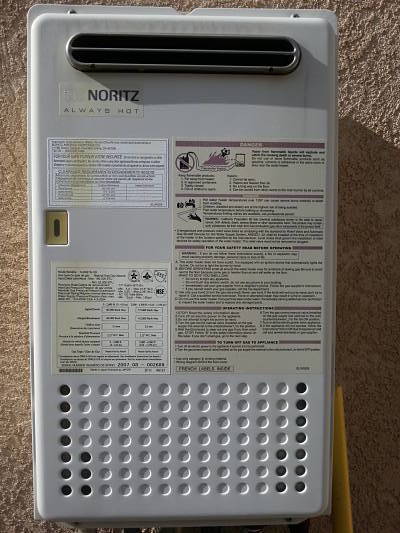 Photo 12-1 |
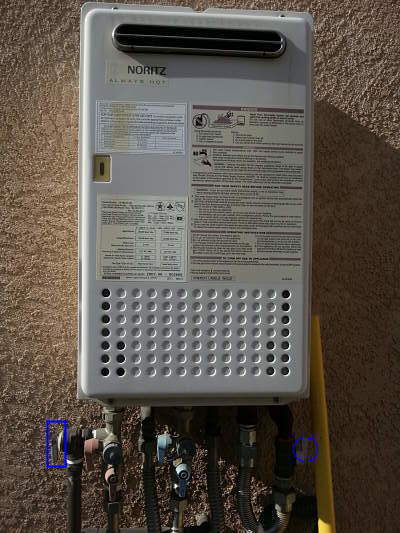 Photo 12-2 The rectangle shows the temperature relief valve. The circle shows the gas shutoff.
|
Roof
Limitations: The following items or areas are not included in this inspection: areas that could not be traversed or viewed clearly due to lack of access; solar roofing components. Any comments made regarding these items are made as a courtesy only. Note that the inspector does not provide an estimate of remaining life on the roof surface material, nor guarantee that leaks have not occurred in the roof surface, skylights or roof penetrations in the past. Regarding roof leaks, only active leaks, visible evidence of possible sources of leaks, and evidence of past leaks observed during the inspection are reported on as part of this inspection. The inspector does not guarantee or warrant that leaks will not occur in the future. Complete access to all roof and attic spaces during all seasons and during prolonged periods of all types of weather conditions (e.g. high wind and rain, melting snow) would be needed to do so. Regarding the roof drainage system, unless the inspection was conducted during and after prolonged periods of heavy rain, the inspector was unable to determine if gutters, downspouts and extensions performed adequately or were leak-free.
Roof inspection method: Viewed from ground. Concrete tile roof. Not advised to traverse unless trained to. Roof appears in serviceable condition and free of debris.
Condition of roof surface material: Appeared serviceable
Roof surface material: Concrete tile
Roof type: Gable, Hipped
Apparent number of layers of roof surface material: One
Condition of gutters, downspouts and extensions: Appeared serviceable. Drains above front porch and garage door have debris. This will not allow water to drain properly and away from the structure. Recommend gutter cleaning.
13)
It is recommended that client add extensions or splash block to downspouts to lead water away from structure.
Attic and Roof Structure
Attic inspection method: Partially traversedPartially traversed due to insulation. Viewed unreachable areas with flashlight from closest point available.
Condition of roof structure: Appeared serviceable
Roof structure type: Trusses, Rafters
Ceiling structure: Ceiling joists
Condition of insulation in attic (ceiling, skylight chase, etc.): Appeared serviceable
Ceiling insulation material: Fiberglass roll or batt
Approximate attic insulation R value (may vary in areas): R-38
Vapor retarder: Installed
Condition of roof ventilation: Appeared serviceable
Roof ventilation type: Ridge vent(s), Gable end vents
Heating, Ventilation and Air Condition (HVAC)
Limitations: The following items are not included in this inspection: humidifiers, dehumidifiers, electronic air filters; solar, coal or wood-fired heat systems; thermostat or temperature control accuracy and timed functions; heating components concealed within the building structure or in inaccessible areas; underground utilities and systems; safety devices and controls (due to automatic operation). Any comments made regarding these items are as a courtesy only. Note that the inspector does not provide an estimate of remaining life on heating or cooling system components, does not determine if heating or cooling systems are appropriately sized, does not test coolant pressure, or perform any evaluations that require a pilot light to be lit, a shut-off valve to be operated, a circuit breaker to be turned "on" or a serviceman's or oil emergency switch to be operated. It is beyond the scope of this inspection to determine if furnace heat exchangers are intact and free of leaks. Condensation pans and drain lines may clog or leak at any time and should be monitored while in operation in the future. Where buildings contain furnishings or stored items, the inspector may not be able to verify that a heat source is present in all "liveable" rooms (e.g. bedrooms, kitchens and living/dining rooms).
General heating system type(s): Forced air
General heating distribution type(s): Ducts and registers
Last service date of primary heat source: 05/21/2012
Source for last service date of primary heat source: Label
Condition of forced air heating/(cooling) system: Appeared serviceable
Forced air heating system fuel type: Electric
Estimated age of forced air furnace: 7 Years
Condition of furnace filters: Required replacement
Location for forced air filter(s): At end of air handler
Condition of forced air ducts and registers: Appeared serviceable
Condition of controls: Appeared serviceable
14)
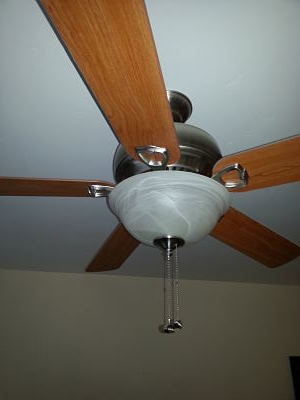 Photo 14-1 |
15)
16)
Electric
Limitations: The following items are not included in this inspection: generator systems, transfer switches, surge suppressors, inaccessible or concealed wiring; underground utilities and systems; low-voltage lighting or lighting on timers or sensors. Any comments made regarding these items are as a courtesy only. Note that the inspector does not determine the adequacy of grounding or bonding, if this system has an adequate capacity for the client's specific or anticipated needs, or if this system has any reserve capacity for additions or expansion. The inspector does not operate circuit breakers as part of the inspection, and does not install or change light bulbs. The inspector does not evaluate every wall switch or receptacle, but instead tests a representative number of them per various standards of practice. When furnishings, stored items or child-protective caps are present some receptacles are usually inaccessible and are not tested; these are excluded from this inspection. Receptacles that are not of standard 110 volt configuration, including 240-volt dryer receptacles, are not tested and are excluded. The functionality of, power source for and placement of smoke and carbon monoxide alarms is not determined as part of this inspection. Upon taking occupancy, proper operating and placement of smoke and carbon monoxide alarms should be verified and batteries should be changed. These devices have a limited lifespan and should be replaced every 10 years. The inspector attempts to locate and evaluate all main and sub-panels. However, panels are often concealed. If panels are found after the inspection, a qualified electrician should evaluate and repair if necessary. The inspector attempts to determine the overall electrical service size, but such estimates are not guaranteed because the overall capacity may be diminished by lesser-rated components in the system. Any repairs recommended should be made by a licensed electrician.
Electric service condition: Appeared serviceable
Primary service type: Underground
Number of service conductors: 2
Service voltage (volts): 120-240
Primary service overload protection type: Circuit breakers
Service entrance conductor material: Not determined (components inaccessible or obscured)
System ground: Concrete encased electrode
Condition of main service panel: Overall good condition. Breakers are marked appropriately.
Condition of sub-panel(s): Appeared serviceable
Location of main service panel: Building exterior, south-facing side
Location of main disconnect: Breaker at top of main service panel
Condition of branch circuit wiring: Serviceable
Branch circuit wiring type: Copper clad
Solid strand aluminum branch circuit wiring present: None visible
Arc fault circuit interrupter (AFCI) protection present: Yes
Smoke alarms installed: Yes, but not tested
Carbon monoxide alarms installed: No, recommend install
17)
18)
http://www.reporthost.com/?SMKALRM
Plumbing / Fuel Systems
Limitations: The following items are not included in this inspection: private/shared wells and related equipment; private sewage disposal systems; hot tubs or spas; main, side and lateral sewer lines; gray water systems; pressure boosting systems; trap primers; incinerating or composting toilets; fire suppression systems; water softeners, conditioners or filtering systems; plumbing components concealed within the foundation or building structure, or in inaccessible areas such as below tubs; underground utilities and systems; overflow drains for tubs and sinks; backflow prevention devices. Any comments made regarding these items are as a courtesy only. Note that the inspector does not operate water supply or shut-off valves due to the possibility of valves leaking or breaking when operated. The inspector does not test for lead in the water supply, the water pipes or solder, does not determine if plumbing and fuel lines are adequately sized, and does not determine the existence or condition of underground or above-ground fuel tanks.
Condition of service and main line: Appeared serviceable
Water service: Public
Location of main water shut-off: Building exterior, south-facing side
Condition of supply lines: Appeared serviceable
Supply pipe material: Copper
Type of irrigation system supply source: Public
Water Pressure: 65 PSI
19)
Kitchen
Limitations: The following items are not included in this inspection: household appliances such as stoves, ovens, cook tops, ranges, warming ovens, griddles, broilers, dishwashers, trash compactors, refrigerators, freezers, ice makers, hot water dispensers and water filters; appliance timers, clocks, cook functions, self and/or continuous cleaning operations, thermostat or temperature control accuracy, and lights. Any comments made regarding these items are as a courtesy only. Note that the inspector does not provide an estimate of the remaining life of appliances, and does not determine the adequacy of operation of appliances. The inspector does not note appliance manufacturers, models or serial numbers and does not determine if appliances are subject to recalls. Areas and components behind and obscured by appliances are inaccessible and excluded from this inspection.
Condition of cabinets: Appeared serviceable
Condition of sinks and related plumbing: Appeared serviceable
Condition of under-sink food disposal: Appeared serviceable
Condition of dishwasher: Required repair, replacement and/or evaluation (see comments below)
Condition of range, cooktop or oven: Appeared serviceable
Range, cooktop or oven type: Natural gas
Type of ventilation: Hood or built into microwave over range or cooktop
Condition of refrigerator: Appeared serviceable
Condition of built-in microwave oven: Appeared serviceable
20)
21)
Bathrooms, Laundry and Sinks
Limitations: The following items are not included in this inspection: overflow drains for tubs and sinks; heated towel racks, saunas, steam generators, clothes washers, clothes dryers. Any comments made regarding these items are as a courtesy only. Note that the inspector does not determine the adequacy of washing machine drain lines, washing machine catch pan drain lines, or clothes dryer exhaust ducts. The inspector does not operate water supply or shut-off valves for sinks, toilets, bidets, clothes washers, etc. due to the possibility of valves leaking or breaking when operated. The inspector does not determine if shower pans or tub and shower enclosures are water tight, or determine the completeness or operability of any gas piping to laundry appliances.
Location #A: Full bath
Location #B: Full bath
Location #C: Master bath
Condition of counters: Appeared serviceable
Condition of cabinets: Appeared serviceable
Condition of flooring: Appeared serviceable
Condition of toilets: Appeared serviceable
Condition of bathtubs and related plumbing: Recommend repair (see comments below)
Condition of ventilation systems: Appeared serviceable
Bathroom and laundry ventilation type: Windows, Central exhaust fan
Gas supply for laundry equipment present: Not determined
240 volt receptacle for laundry equipment present: Yes
22)
Interior, Doors and Windows
Limitations: The following items are not included in this inspection: security, intercom and sound systems; communications wiring; central vacuum systems; elevators and stair lifts; cosmetic deficiencies such as nail-pops, scuff marks, dents, dings, blemishes or issues due to normal wear and tear in wall, floor and ceiling surfaces and coverings, or in equipment; deficiencies relating to interior decorating; low voltage and gas lighting systems. Any comments made regarding these items are as a courtesy only. Note that the inspector does not evaluate any areas or items which require moving stored items, furnishings, debris, equipment, floor coverings, insulation or similar materials. The inspector does not test for asbestos, lead, radon, mold, hazardous waste, urea formaldehyde urethane, or any other toxic substance. Some items such as window, drawer, cabinet door or closet door operability are tested on a sampled basis. The client should be aware that paint may obscure wall and ceiling defects, floor coverings may obscure floor defects, and furnishings may obscure wall, floor and floor covering defects. If furnishings were present during the inspection, recommend a full evaluation of walls, floors and ceilings that were previously obscured when possible. Determining the cause and/or source of odors is not within the scope of this inspection.
Condition of exterior entry doors: Appeared serviceable, Required repair, replacement and/or evaluation (see comments below)
Exterior door material: Wood, Fiberglass or vinyl, two dual-pane sliding glass doors with fiberglass framing. All other exterior doors are wood.
Condition of interior doors: Appeared serviceable
Condition of windows and skylights: Appeared serviceable
Type(s) of windows: Vinyl, Multi-pane, Sliding, Single-hung
Condition of walls and ceilings: Appeared serviceable, one defect noted below.
Wall type or covering: Drywall
Moisture levels in drywall: Normal throughout home
Ceiling type or covering: Drywall
Condition of flooring: Appeared serviceable, Recommended repairs (see comments below)
Flooring type or covering: Carpet, Vinyl, linoleum or marmoleum, Tile
23)
**Sliding glass door off of living room is tempered safety glass. Unable to verify sliding glass door in master bedroom. A qualified technician should inspect, this is a safety hazard.
24)
-Garage door leading into backyard had damage to door frame on both sides, possibly from moving something large through the door. This damage does not affect the functionality of the door, it is cosmetic.
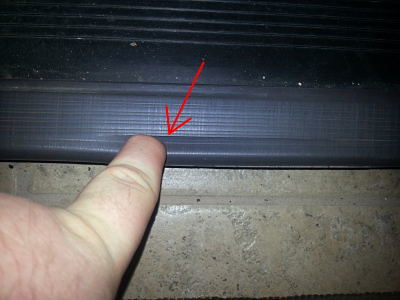 Photo 24-1 Sill has hairline crack and makes popping sound if stepped on.
|
25)
Exterior storage, south-facing side, door sticks when opening and closing. Most likely due to structural settling.
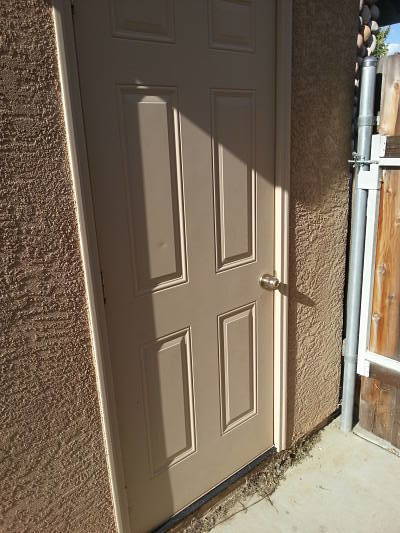 Photo 25-1 |
26)
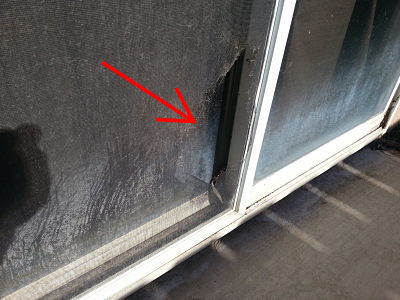 Photo 26-1 |
27)
28)
Master Bathroom toilet paper holder is loose. Recommend repair.
29)
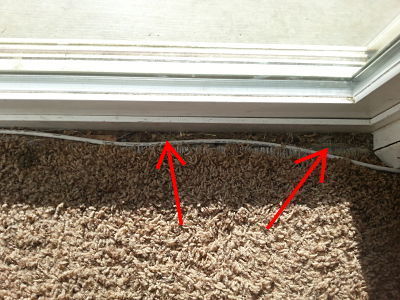 Photo 29-1 |
30)
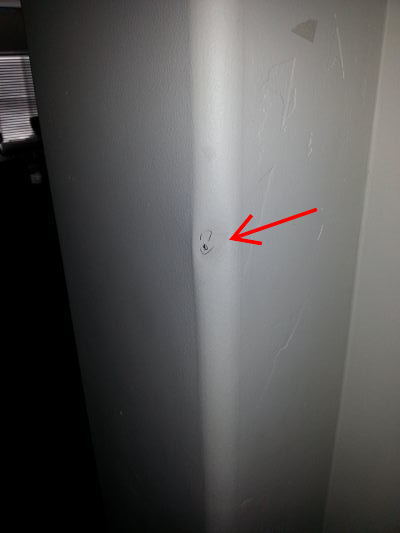 Photo 30-1 |
Garage or Carport
Limitations: The inspector does not determine the adequacy of firewall ratings. Requirements for ventilation in garages vary between municipalities.
Type: Attached, Garage
Condition of door between garage and house: Appeared serviceable
Type of door between garage and house: Solid core, Wood
Condition of garage vehicle door(s): Appeared serviceable
Type of garage vehicle door: Roll
Number of vehicle doors: 1
Condition of automatic opener(s): Appeared serviceable
Mechanical auto-reverse operable (reverses when meeting reasonable resistance during closing): Yes
Condition of garage floor: Appeared serviceableSome of floor obstructed from view by personal belongings.
Condition of garage interior: Appeared serviceable
Garage ventilation: None visible
31)
http://www.reporthost.com/?AGFR
32)
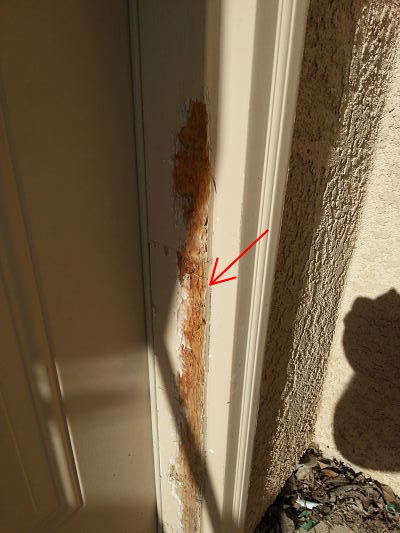 Photo 32-1 |
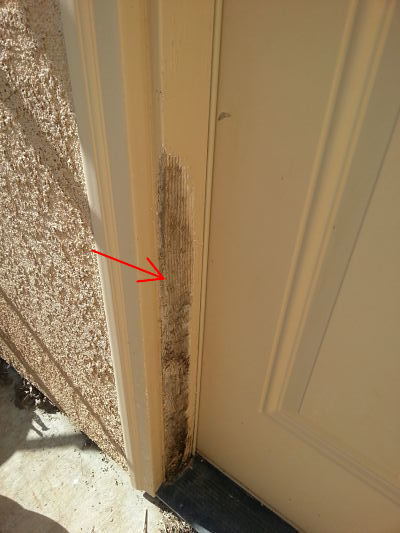 Photo 32-2 |
The Inspector may, at his or her discretion:
Inspect any building, system, component, appliance, or improvement not included or otherwise excluded by these Standards of Practice. Any such inspection shall comply with all other provisions of these Standards.
Include photographs in the written report or take photographs for Inspector’s reference without inclusion in the written report. Photographs may not be used in lieu of written documentation.
Limitations, Exceptions and Exclusions
The following are excluded from a real estate inspection:
-Systems or components of a building, or portions thereof, which are not readily accessible, not permanently installed, or not inspected due to circumstances beyond the control of the Inspector or which the Client has agreed or specified are not to be inspected.
-Site improvements or amenities, including, but not limited to; accessory buildings, fences, planters, landscaping, irrigation, swimming pools, spas, ponds, waterfalls, fountains or their components or accessories.
-Auxiliary features of appliances beyond the appliance’s basic function-
-Systems or components, or portions thereof, which are under ground, under water, or where the Inspector must come into contact with water.
-Common areas as defined in California Civil Code section 1351, et seq., and any dwelling unit systems or components located in common areas.
-Determining compliance with manufacturers’ installation guidelines or specifications, building codes, accessibility standards, conservation or energy standards, regulations, ordinances, covenants, or other restrictions.
-Determining adequacy, efficiency, suitability, quality, age, or remaining life of any building, system, or component, or marketability or advisability of purchase.
-Structural, architectural, geological, environmental, hydrological, land surveying, or soils- related examinations
-Acoustical or other nuisance characteristics of any system or component of a building, complex, adjoining property, or neighborhood.
-Risks associated with events or conditions of nature including, but not limited to; geological, seismic, wildfire, and flood.
-Water testing any building, system, or component or determine leakage in shower pans, pools, spas, or any body of water.
-Determining the integrity of hermetic seals at multi-pane glazing.
-Differentiating between original construction or subsequent additions or modifications.
-Reviewing information from any third-party, including but not limited to; product defects, recalls, or similar notices.
-Specifying repairs/replacement procedures or estimating cost to correct.
-Communication, computer, security, or low-voltage systems and remote, timer, sensor, or similarly controlled systems or components.
-Fire extinguishing and suppression systems and components or determining fire resistive qualities of materials or assemblies.
-Elevators, lifts, and dumbwaiters.
-Lighting pilot lights or activating or operating any system, component, or appliance that is shut down, unsafe to operate, or does not respond to normal user controls.
-Operating shutoff valves or shutting down any system or component.
-Dismantling any system, structure, or component or removing access panels other than those provided for homeowner maintenance.
Again, thank you for choosing Twinspections for your inspection needs!
